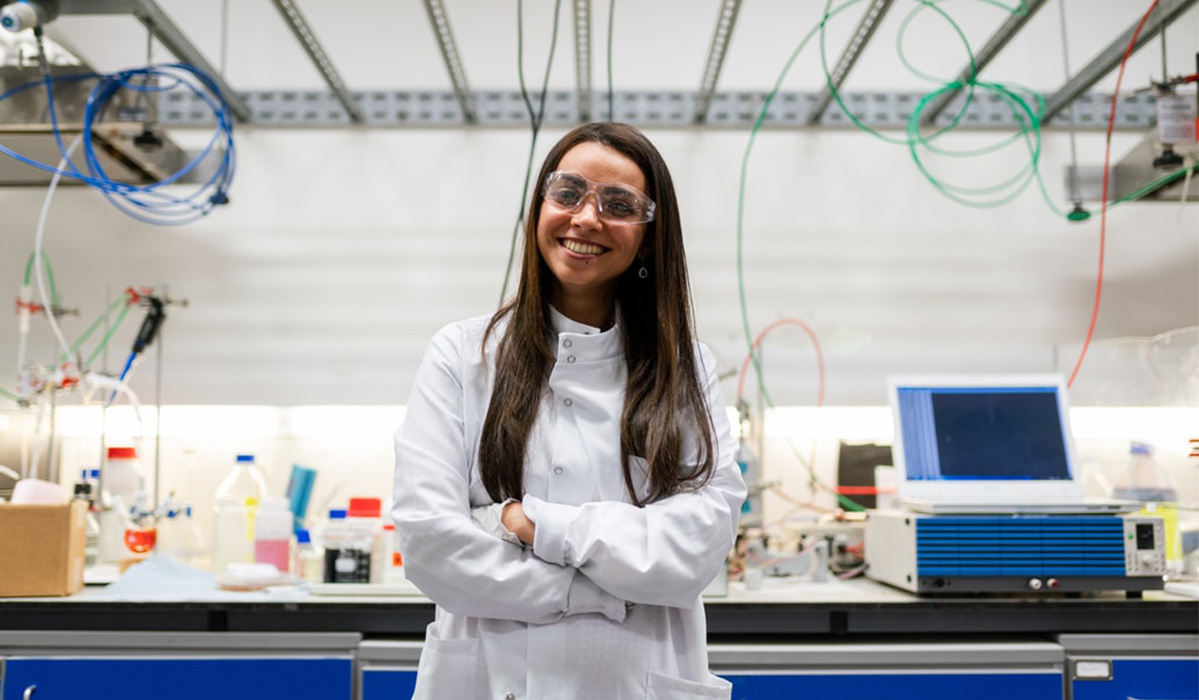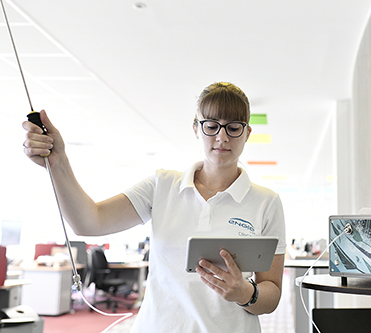So as thousands of young entrepreneurs, researchers and engineers hatch up new sustainable solutions every year, we put together a brief list of some of the best innovations and the faces behind them:
Two-in-one wind turbine

Growing up in the southern state of Andhra Pradesh, Madhu Vajrakarur was one of the 88 million people in India deprived of safe drinking water. In his native village, water was drawn from borewells, and during periods without rain, Vajrakarur’s family had to buy or borrow water from neighbours. It was these tough conditions that spurred the now 23-year-old electrical engineering student to build a two-in-one wind turbine that can generate electricity and clean water.
- Built from plastic pipes, iron rods, and other elements purchased online, Vajrakarur constructed a 15-foot wind turbine that provides him and his neighbours with 80 to 100 litres of water every day.
- The design gathers moisture from the atmosphere through a blower placed at the back of the fan. Once the cool air enters the turbine’s frame, the moisture is directed to a cooling compressor which condenses it into water.
- After passing through copper pipes into a three-stage membrane, carbon and UV filter, the clean water is accessed through a tap placed on the frame.
- The wind turbine is connected to an inverter with 30-kilowatt capacity powering fans, lights and power outlets in Vajrakarur’s home.
The pipeline inspector
While finishing her undergraduate degree in physics at the University of Amsterdam, INGU cofounder Anouk van Pol was already working on the first trial of her company’s pipeline inspection tool in collaboration with Shell Oil. The design: a baseball-sized sensory device that can detect blockages and leaks in oil, gas and water pipelines.
- The so-called “pipers” — essentially a ball packed with sensors — can float freely inside pipelines previously considered inaccessible. Along the way, they record up to 24 hours of data for subsequent analysis.
- In addition to leaks and blockages, the ball also picks up on potential hazards as well as identifying areas of metal loss by measuring the pipeline’s magnetic flux.
- In 2017, INGU was selected for Chevron's new Catalyst Program, supporting startups in oil and gas. INGU built a pilot project for Chevron, and followed up with deployments across the U.S. and Canada with 75 customers.
Powering South Africa with offgrid solar

It was back in 2014, while working on a biogas project in South Africa, that Kwanda Jakalase and Randolph Bruce Meth had an idea for how to reshape the renewable energy market of South Africa. The longtime friends from school and church identified untapped potential for solar power in a sun-blessed country where electricity prices have skyrocketed over the last decade. That was the debut of what is today Silicon Energy Technology.
- The company produces solar and energy storage systems adapted to off-grid needs and to mitigate load shedding — a perennial issue in South Africa. The systems are tailored to fit the end users’ needs and can be used for households, offices or businesses.
- The flagship product is a portable generator to charge devices like phones, laptops, lights, and microwaves. Its most advanced feature is the ability to charge it by multiple power sources including solar panels, wind turbines and hydro-turbines.
- Silicon Energy Solutions offers to adjust its pricing to the income level of the user.
Catching waves
At the age of 24, Israeli entrepreneur Inna Braverman co-founded Eco Wave Power with the aim of turning ocean and sea waves into green electricity. Under her leadership, the company installed its first grid-connected wave energy array in Gibraltar in 2016, and became the first company from Israel to ever list on Nasdaq Stockholm.
- After several years of testing and development, the company’s innovative wave catchers became the first wave power station connected to an electrical grid in Europe. These floaters draw energy from incoming waves by converting the rising and falling motion of the waves into a clean energy generation process.
- The structure is controlled and monitored by a smart automation system that allows the floaters to automatically adjust to the different height of waves, and also to rise above the water level when the waves are too high for the system to handle.
- Eco Wave Power currently holds a significant projects pipeline of more than 190MW worldwide.
Coffee grinds to clean heat energy

Arthur Kay’s journey from architect to waste-energy innovator started with a cup of coffee. In 2013, when the now 30-year-old Kay noticed a thin film of oil on top of his cold Americano, he started to wonder whether the waste could be harnessed for energy. That idea eventually turned into Bio Bean, a London-based company that collects grounds from coffee shops, restaurants and offices and converts them into energy-rich pellets.
- The pellets offer an alternative to traditional carbon-heavy fuels as they can be burned to warm ovens and even heat entire buildings. They also boast a calorific value 15% higher than standard timber pellets.
- Bio Bean also saves UK businesses millions of pounds in coffee waste disposal fees while slashing associated emissions from transport.
Breath of fresh air in ENGIE Lab CRIGEN

As a young engineer, Hélène Buée joined ENGIE’s “Nanotech, Sensors & Wireless” research team as an intern in analytical chemistry back in 2013. She eventually became a key member of the team at ENGIE’s strategic CRIGEN Lab, focused on BREATHE, a project that is bringing crucial innovations to air quality.
Hélène Buée explained that cities must meet with a range of European regulations and targets on the concentration of a number of air pollutants, such as Nitrogen dioxide (NO2) and Particulate Matters (PM2.5 and PM10). In response, and until measures taken by the cities show results, BREATHE is developing complementary and temporary solutions to treat the air locally through remediation techniques. “Our goal is to analyze the air to identify the main pollutants and their concentration but also the environmental setting and several other factors,” she explained. “We then determine which innovative technology would be the most appropriate to reduce their concentration without using too many resources. Improving air quality shouldn’t come at the expense of creating other environmental damage,” Hélène Buée says.
- Top methods. Among the remediation techniques employed:
1. vegetalization and vegetal walls, which are effective
in combating CO2, NO2
and particles and also bring freshness during hot weather.
2. electrostatic precipitation sends fine
particles through electrically charged posts causing them to agglomerate,
become heavier and eventually falling off to be collected and potentially
recycled;
3. filters, such as carbon
filters, trap gases and particles, though require constant maintenance to
ensure they are clogged up enough to be efficient but don’t become
over-saturated;
4. aqueous precipitation, which just like rain, will capture particles and
some pollutants like NO2 and SO2 (sulfur dioxide) and
make them drop, but means residual water has to be watched to avoid putting
back polluted water in the waste water network.
- Testing time: The first in situ experiment took place in 2019,
on a heating plant in the Parisian suburb of Saint Ouen. The study and
evaluation of remediation solutions is still ongoing but already allowed ENGIE
Solutions and ENGIE Lab CRIGEN to create an offer and respond to invitations to
tender. The tech designed for the plant is now treating up to 3,000m³ of air
per hour.
- School air: Thanks to this first experiment, project BREATHE won
in 2020 a tender for the city of Vélizy-Villacoublay (France, 78) and will
start this year working on remediation solutions in a nursery school.
- Looking ahead: In 2021, a testing site
will also be launched within ENGIE Lab CRIGEN to better evaluate use cases and
validate results and adequate solutions. “We won’t have sites to work on all
the time, but we have to be as exhaustive as possible in our study and offer so
this testing site will be a good way to keep up the pace in our research”,
Hélène Buée says.


